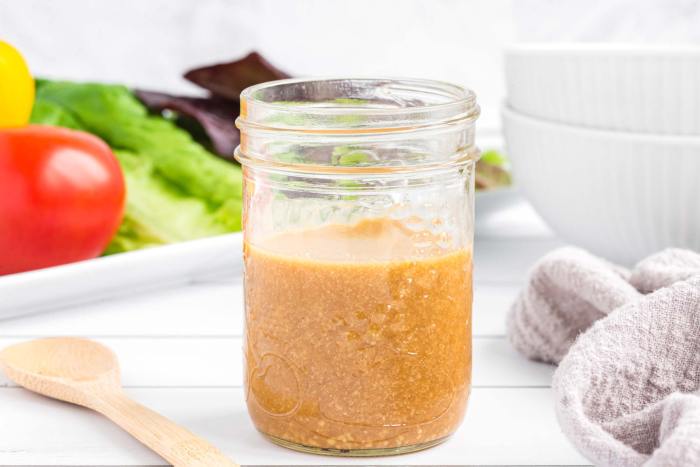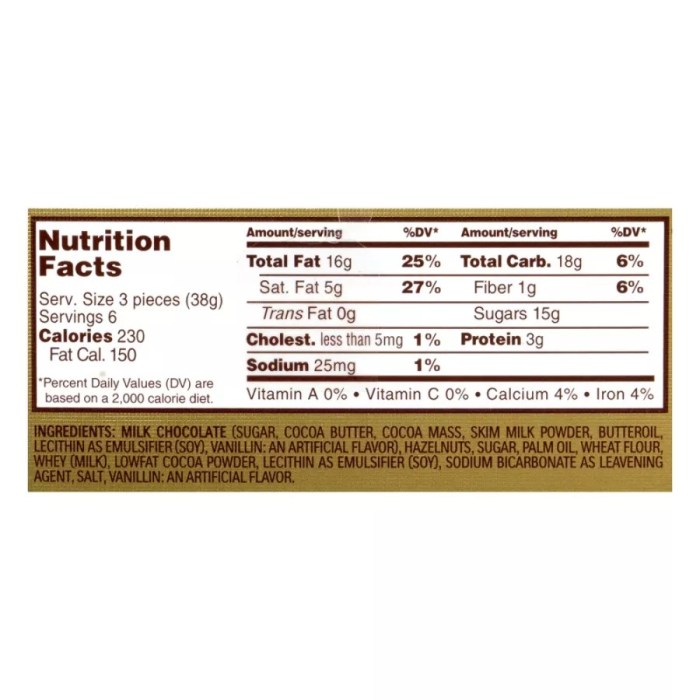Ingredient Breakdown of Ginger Miso Dressing
Ginger miso dressing nutrition facts – Ginger miso dressing is a versatile condiment, prized for its savory-sweet flavor profile and ability to enhance a wide array of dishes. Understanding its ingredient composition provides insight into its nutritional value and flavor complexity. This section details the typical ingredients, their quantities in a standard recipe, and their respective nutritional contributions.
Typical Ingredients and Quantities
A standard recipe for ginger miso dressing typically includes a combination of ingredients, with variations depending on personal preference and culinary application. The following table illustrates a common recipe and the approximate quantities used. Keep in mind that these are estimates, and adjustments may be needed to achieve the desired consistency and flavor profile.
| Ingredient | Quantity (Approximate) | Nutritional Contribution per Serving (Estimates) | Notes |
|---|---|---|---|
| White or Yellow Miso Paste | 2-3 tablespoons | Source of probiotics, protein, and various vitamins and minerals (particularly sodium). | Provides the umami base and salty flavor. White miso is milder than yellow. |
| Rice Vinegar | 1-2 tablespoons | Provides acidity and balances the sweetness and saltiness. Adds a subtle tang. | Adds brightness and cuts through the richness of the miso. |
| Fresh Ginger | 1-2 tablespoons (grated) | Source of gingerol, an antioxidant with anti-inflammatory properties. Adds a pungent, warming flavor. | The amount can be adjusted based on desired intensity of ginger flavor. |
| Sesame Oil | 1-2 teaspoons | Adds richness and nutty aroma. Source of healthy fats. | Toasted sesame oil offers a more intense flavor. |
| Honey or Maple Syrup | 1-2 teaspoons | Provides sweetness and balances the savory notes. | The type of sweetener can be adjusted based on dietary preferences. |
| Soy Sauce (or Tamari for gluten-free) | 1 teaspoon | Adds saltiness and umami. Source of sodium. | Use tamari for a gluten-free option. |
| Water | 1-2 tablespoons | Adjusts the consistency of the dressing. | Added gradually to achieve desired thickness. |
Nutritional Contribution of Each Ingredient
The nutritional profile of ginger miso dressing is largely determined by its constituent ingredients. Miso paste contributes probiotics beneficial for gut health, while ginger offers antioxidants. The addition of sesame oil provides healthy fats, while the vinegar and sweeteners contribute to the overall flavor profile and energy content. The sodium content should be considered, especially for individuals with sodium restrictions.
It’s important to note that the exact nutritional content will vary depending on the specific ingredients used and their quantities. Always check the nutritional information of individual ingredients for a more precise calculation.
Macronutrient Profile

Ginger miso dressing, while delicious and versatile, offers a unique macronutrient profile compared to other popular salad dressings. Understanding this profile can help individuals make informed choices about incorporating it into their diet, particularly considering factors like calorie intake and dietary goals. The macronutrient composition varies slightly depending on the specific recipe, but a general overview provides a useful benchmark.The macronutrient content of ginger miso dressing is primarily driven by its ingredients: miso paste (fermented soybeans), rice vinegar, ginger, and often oil (such as sesame or avocado oil).
These components contribute varying levels of carbohydrates, protein, and fats. While precise values depend on the recipe and serving size, we can examine typical ranges and compare them to other common options.
Macronutrient Comparison of Salad Dressings
The following table compares the approximate macronutrient profile of a typical serving (approximately 2 tablespoons) of ginger miso dressing to those of ranch and a vinaigrette dressing. It’s important to note that these are estimates, and the actual values can vary significantly depending on specific brands and recipes. For instance, a vinaigrette made with a higher oil-to-vinegar ratio will naturally have a higher fat content.
Similarly, the type of oil used dramatically impacts the overall fat profile.
| Dressing Type | Carbohydrates (g) | Protein (g) | Fat (g) |
|---|---|---|---|
| Ginger Miso Dressing | 5-7 | 1-2 | 8-12 |
| Ranch Dressing | 2-4 | 1-2 | 10-15 |
| Vinaigrette (Oil & Vinegar) | 1-2 | 0-1 | 12-18 |
Allergens and Dietary Considerations

Ginger miso dressing, while delicious and versatile, contains ingredients that may pose concerns for individuals with certain allergies or dietary restrictions. Understanding these potential issues and exploring suitable modifications is crucial for ensuring everyone can enjoy this flavorful condiment. This section will highlight common allergens, discuss dietary adaptations, and provide specific substitution suggestions.Allergens commonly found in ginger miso dressing include soy (from miso paste) and gluten (potentially present in some types of miso or added tamari).
Sesame seeds are also sometimes included, adding another potential allergen. Careful ingredient selection and clear labeling are essential for managing these risks.
Dietary Modifications for Ginger Miso Dressing
Making this dressing suitable for various diets requires mindful ingredient substitutions. The following list details modifications for common dietary needs.
- Vegan Adaptation: Most traditional ginger miso dressings are already vegan, as they typically consist of miso paste, ginger, rice vinegar, sesame oil, and sweeteners like maple syrup or agave nectar. However, always double-check the ingredients of your miso paste and other components to ensure they are free from animal products.
- Gluten-Free Adaptation: The primary concern here is the miso paste. Many miso pastes are made with wheat, containing gluten. To make the dressing gluten-free, ensure you use a certified gluten-free miso paste. Tamari, often used as a substitute for soy sauce, can also contain gluten unless specifically labeled gluten-free. Choose tamari accordingly.
- Low-Sodium Adaptation: Miso paste and soy sauce are naturally high in sodium. To reduce the sodium content, use low-sodium or reduced-sodium miso paste and soy sauce (or tamari). You can also increase the amount of other ingredients, such as ginger or rice vinegar, to balance the flavor without adding more salt. Consider using a touch of sweetness like maple syrup to help compensate for the reduced saltiness.
Understanding the nutritional profile of ginger miso dressing is important for balanced eating. A key aspect to consider is the overall caloric intake, which can be easily managed when paired with a nutritious grain like wild rice. For more information on the nutritional benefits of this grain, check out this resource on wild rice nutrition facts. Returning to the dressing, its sodium content should also be considered, as it can impact your daily intake.
Ingredient Substitutions for Dietary Modifications
The table below Artikels specific ingredient substitutions to accommodate various dietary needs.
| Dietary Restriction | Original Ingredient | Suggested Substitution |
|---|---|---|
| Gluten-Free | Wheat-based Miso Paste | Certified Gluten-Free Miso Paste (rice, barley, or soy-based) |
| Gluten-Free | Tamari | Certified Gluten-Free Tamari |
| Low-Sodium | Regular Miso Paste | Low-Sodium Miso Paste |
| Low-Sodium | Soy Sauce/Tamari | Low-Sodium Soy Sauce/Tamari |
| Vegan (if applicable) | Honey | Maple Syrup or Agave Nectar |
Visual Representation of Nutritional Information
A visually appealing and informative nutrition label is crucial for conveying the nutritional content of ginger miso dressing effectively to consumers. Clear organization and strategic use of visual elements can significantly enhance understanding and encourage healthier choices. This section details the design and layout of a hypothetical nutrition label, focusing on clarity and user-friendliness.
Nutrition Label Design and Layout
The label would be rectangular, approximately 4 inches wide by 3 inches tall, to ensure sufficient space for all necessary information without appearing overcrowded. The background color would be a light, neutral beige to provide contrast and visual appeal. A clean, sans-serif font such as Arial or Calibri would be used throughout, with varying font sizes to create a hierarchy of information.
The main heading, “Ginger Miso Dressing Nutrition Facts,” would be displayed prominently at the top in a bold, slightly larger font size (14pt).
Serving Size and Calories
The serving size (“2 tablespoons”) would be clearly stated near the top, followed immediately by the number of calories per serving (approximately 70-80, depending on the specific recipe). The calorie count would be in a larger, bolder font (12pt) to draw attention, given its importance to consumers.
Macronutrient Information, Ginger miso dressing nutrition facts
Below the calorie count, a table would present the macronutrient information: total fat, saturated fat, trans fat, cholesterol, sodium, total carbohydrate, dietary fiber, total sugars, and protein. Each nutrient would be listed with its corresponding value in grams or milligrams, along with the percentage of the Daily Value (%DV) where applicable. The %DV would be displayed in parentheses next to each value to allow consumers to easily compare the nutrient content to their daily intake recommendations.
The table would use clear horizontal and vertical lines to separate rows and columns for improved readability. A lighter color might be used to shade alternating rows to further enhance visual organization.
Micronutrient Information
Under the macronutrient table, a smaller section would list key micronutrients, such as Vitamin A, Vitamin C, and any other significant vitamins or minerals present in notable quantities. These would be listed with their amounts and %DV, if available. The font size for this section could be slightly smaller (10pt) than the macronutrient section.
Color Coding and Visual Cues
Strategic use of color could further enhance the label’s readability. For example, the %DV values could be color-coded; values exceeding 20% could be highlighted in a light red to subtly draw attention to potentially high levels of certain nutrients. Similarly, nutrients contributing to overall health could be presented with a different, less attention-grabbing color, like a light green.
Impact of Ingredient Variations
The nutritional profile of ginger miso dressing is significantly influenced by the specific ingredients used. Variations in miso type and ginger variety, for instance, alter the balance of macronutrients and micronutrients present. Understanding these variations allows for customization of the dressing to better suit individual dietary needs and preferences. This section will delve into the impact of these ingredient choices on the overall nutritional content.The type of miso used drastically affects the flavor and nutritional composition of the dressing.
Different miso pastes—white, yellow, and red—vary in their fermentation processes and resulting nutrient profiles. This difference stems from the types of soybeans and grains used, as well as the length and specifics of the fermentation process.
Miso Type and Macronutrient Comparison
The table below illustrates a comparative analysis of the macronutrient content of ginger miso dressings made with different types of miso. Note that these values are approximate and can vary depending on the specific brand and recipe used. Accurate values should be calculated based on the specific ingredients used in each preparation.
| Miso Type | Carbohydrates (g/100g) | Protein (g/100g) | Fat (g/100g) |
|---|---|---|---|
| White Miso | 15-20 | 10-15 | 5-8 |
| Yellow Miso | 12-18 | 12-16 | 6-10 |
| Red Miso | 10-15 | 15-20 | 7-12 |
Answers to Common Questions: Ginger Miso Dressing Nutrition Facts
What is the best way to store homemade ginger miso dressing?
Store homemade ginger miso dressing in an airtight container in the refrigerator for up to a week for optimal freshness.
Can I freeze ginger miso dressing?
Freezing ginger miso dressing is possible, but it may alter the texture slightly upon thawing. It’s best used fresh.
Is ginger miso dressing suitable for low-carb diets?
The suitability of ginger miso dressing for low-carb diets depends on the specific recipe and serving size. It contains carbohydrates, so moderation is key.
Are there any good substitutes for miso paste in this dressing?
While miso paste provides the unique umami flavor, tahini or white miso can offer alternative flavor profiles, though the nutritional content will differ.



